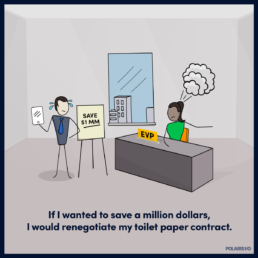Once you understand how agreement networks inside a customer enterprise work and have identified the executive buyers, it’s time to hone your approach. Salespeople need a new strategy for communicating value in order to sell to high-level executives.
Helping senior executives with buyer roles envision outcomes is a critical success factor when it comes to creating demand. It’s easy to say but hard to do. And it’s even harder to do when your communication system is designed around your products and services vs. your customers’ business objectives and challenges.
Communicating Value to Executive Buyers Is a Specialized Function
Value communication is not a repeatable process for most companies. Why? Because there are so many internal factors to overcome. Business silos, uncoordinated efforts, product-centric goals and measurements, lack of consistent customer feedback, just to name a few, create misalignment. Because of these factors, leadership focuses on improving product-centric sales models instead of aligning to create value for customers. When traditional product demand dries up, new sales approaches are warranted.
Is your organization ready to embrace a customer-centric approach? In a recent report from Gartner, only 6 percent of CSOs say they are extremely confident about their team’s ability to meet or exceed revenue goals. Most sales leaders site changing buyer preferences — more conservative decision making, new preferences as a result of remote work, or increased digital expectations — as directly impacting sales.
The Characteristics of Being Product-Centric vs. Customer-Centric
Most sales pipelines reflect a product-centric state. Selling stages are focused on what progress salespeople think they are making instead of what progress their customers think they are making. The two perspectives, product vs. problem, are often very far apart. And they grow farther apart the larger the pursuit – but there isn’t a mechanism to “see” the distance between these two worlds.
From Product-centric vs Customer-centric

What Do Enterprise Executive Buyers Care About?
When you’re creating customer-centric buying experiences with senior-level or executive buyers in large scale enterprise or global 2000 companies, the potential for steady revenue growth is huge.
Mapping backwards from your customer to organize and articulate your capabilities in terms of value impact from their perspective is a simple process. However, it’s a major shift in mindset. It requires a commitment within your organization to remove the friction in your commercial system and orchestrate creating value for the customer across internal silos. The results are well worth the time and effort.
Learn more in our webinar: Routes to Value: Enable Your Customers to Buy Complex Solutions
Customer-Centric Value Impact Goes Beyond Revenue
When you stop focusing on selling products and start focusing on customer outcomes – you’ll be surprised how receptive executive buyers will be. By aligning your organization with theirs and creating a shared vision of success, you’ll start driving bigger deals much faster.
These larger deals also increase the value of your company for investors. Because of the outsized value of larger contracts with global 2000 companies, the effect that these contracts have on stock price can be significant. Efficient revenue growth anchored against high-value targets that provide unlimited growth potential is rewarded by investors who recognize the long-term value of these clients.
Augment Your Ability to Go to Customer with Sales Enablement Tools
Increase your confidence in your sales team’s ability to have more meaningful conversations with enterprise customers. At Polaris I/O, we help our clients quickly unlock value for large scale accounts using a holistic go-to-customer platform that combines professional services with powerful apps and centralized data. Contact us for more information.
Stay tuned for more insights from our Economy of Enterprise Accounts series.
Dave Irwin
Founder + CEO of Polaris I/O
Dave has 30 years of experience in B2B as President, GM, CMO, and CSO. He is recognized as an AI, marketing, and sales enablement expert. He is also a growth leader with a strong history of innovation.
Related Posts
The Business Case for the Commercial Insight Strategist: Unlocking Growth with Precision
In enterprise sales, growth is often…
The Commercial Insight Strategist: A Key Asset for Key Account Teams
Imagine a key account team working…






